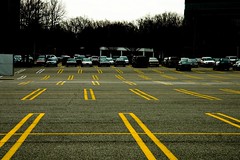 I am often saddened by our reliance on cars (and trucks, vans, SUVs, etc.) in our society today. I strongly dislike having to drive most places if I want to do anything, and I cringe every time I drive/walk/bike by businesses and especially strip malls that are mostly parking lot (and at most times during a 24 hour period, empty parking lots). (Photo from Flickr by jgrimm / CC BY-NC-ND 2.0)
I am often saddened by our reliance on cars (and trucks, vans, SUVs, etc.) in our society today. I strongly dislike having to drive most places if I want to do anything, and I cringe every time I drive/walk/bike by businesses and especially strip malls that are mostly parking lot (and at most times during a 24 hour period, empty parking lots). (Photo from Flickr by jgrimm / CC BY-NC-ND 2.0)I enjoyed reading this blog post from WorldChanging about car-free cities. Check it out.
I thoroughly enjoy traveling to a place that is much less reliant on vehicles than my city of Fresno, such as San Francisco, the East Coast of the US, Europe, etc. I love the ability to get anywhere and everywhere without having to rely on a car. In fact, it's a lot less stress to not have to worry about a car, parking, maintenance, gas, and cleaning among others. But, the big question is. Is this really possible in our society, especially highly developed western cities that were built around cars? Not too mention the stress and possible waste of time driving (as opposed to taking public transportation, where you can focus on activities other than driving). It will likely be a fairly involved change, but it does not have to be difficult, it just requires a paradigm shift. Here are my ideas for making a less car dependent society.
- More mass transit - You've read about my love of high speed rail on this blog, and this concept fits in very well with that. Clean, fast, and modern transportation, such as high speed rail can easily connect distances of 400 miles or less. High speed rail can also easily replace a lot of air travel, such as in Spain where the newest route of high speed rail between Madrid and Barcelona has already replaced half of air travel on the busiest air route in the world (in only a years time). One of the great features of High Speed Rail is the placement of stations in the center of cities, as opposed to large airports that are often on the outskirts of cities or farther, and require extra transportation to get there. In Europe the fastest way to get from downtown London to downtown Paris is high speed rail (and Britain is an island!).
- More public transit - Once you get into a city using mass transit like high speed rail you should have the ability or option to walk to your destination, but often time or distance might be a factor. Without a good public transit system you give people few other options to driving. Misconceptions are also a problem with public transit in places where cars are king. Here in Fresno, CA the buses have a bad reputation, which is unwarranted and unfortunate because it is usually the people that don't use the bus that feel this way. I would love to commute to work without having to worry about rush hour traffic, other crazy drivers, and finding a good parking spot. The way to make this more attractive to people who like the freedom of cars is to have more buses (or other public transit) and more routes.
- More urban infill - Suburbanization which has been a trend for a long time is starting to show its major detractions. People getting more and more spread out leads to more vehicular use, longer commute times, longer commute distances, loss of agriculture/farm land, and strong relationship between cost of commute and gas prices, among others. The higher density of people living in an area, the closer amenities will be to serve these people. That means you won't be forced to drive two miles to the closest grocery store. Urban infill also helps make public transit more effective by concentrating the areas that are covered by routes. This can be accomplished two major ways. First, unoccupied buildings can be repurposed to include higher density housing. For example, in Fresno there are many high-rise buildings that are sitting empty that would make great housing buildings, in fact "In the past, the city council [of Fresno] requested that the vacant downtown buildings be inventoried and the results were the size of the two lost World Trade Center Towers" (Via Fresno Fusion). Second, places (especially business/strip malls) that have in the past included a lot of wasted parking space can repurpose that land to include higher density living, etc. Another big factor in urban infill is focusing on building up rather than out.
What do you think is important for our cities?



5 comments:
I definitely love living in a city where not using a car is an option (for me, at least). I will be honest, though, it takes me a lot longer to get from one place to another. I can work from my blackberry while traveling, but it means leaving earlier for work, etc. I have also gotten ill from being coughed on in the train. Also, each trip is more expensive than a trip in a car would take (if you work out the math for how much it would cost for gas vs metro or bus). Those are the only real complaints I have. I mean, there is the occasional homeless person who bothers you, and sometimes the air conditioning doesn't work, but it's nice to never worry about brake pads or filling up for gas. Also, when you consider the cost of maintaining a car (oil changes and the like), the cost of traveling by mass transit is negligible.
Environmentally it's great, which is a concern of mine. I breathe better in DC than I did in Fresno. Another benefit, which was unforeseen, was that I lost a little bit of weight from the constant walking.
As far as changing suburban areas that were made for cars into their urban counterpart mass transit equals--it'll never happen. A place like Fresno needs a better bus system to start. It also needs to be marketed better. Something like the DC Circulator would be great for Fresno. A metro would never work.
Those are my thoughts.
Interesting point of view Laura, thanks for commenting! I think cost of travel should be compared equally to the government standard of travel reimbursement, of $0.585 per mile. At this rate, it doesn't take a very far commute on a bus or metro/subway to come out ahead.
You are right though too, sometimes it does take longer to commute if you aren't driving, but the hassle and worry goes away completely when you don't have to worry about driving. Plus, parking should be considered as well.
I think Fresno can change into a more urban area. If more high-rise apartments were built, an area like Riverpark could be a very densely populated area. Take downtown, tower district, Fresno city college, Fig Garden village, Fresno State University, and Riverpark, you could easily make a metro/light-rail system with the right high-density living plans.
you need to read the book suburban nation. it really opened my eyes to the downfalls of suburban sprawl in every aspect of living-- emotionally, physically, aesthetically, etc. they talk a lot about the reliance on cars and how detrimental it has been to our way of living. it's one of my favorite books.
Thanks Mikkele! That book is going on my Christmas wish list!
yes! do it.
Post a Comment